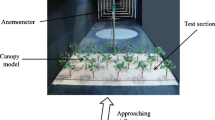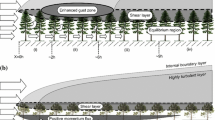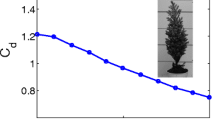Abstract
Windbreak has been used for centuries as a natural wind-fence. The functional effects of windbreaks are directly related to the flow structure. In the present study, the flow around a real fir tree placed in a wind tunnel was quantitatively visualized using PIV (particle image velocimetry) technique. The effects of tree porosity and leaves on the shelter effect were investigated as well. Tree leaves not only reduce the porosity, but also increase the wind-speed reduction and turbulence kinetic energy in the leeward region behind the tree canopy. The leaves of tree canopy induce updraft toward the top region and downdraft toward the ground in the upstream region of the tree. The momentum difference of these two flows generates peculiar upwelling flow characteristics. The large reduction in mean velocities and turbulence intensities of flow around a tree is attributed to tree leaves providing a good shelter zone in the leeward region.
Similar content being viewed by others
References
W. M. Cornelis and D. Gabriels, Optimal windbreak design for wind-erosion control, J. Arid. Environ., 61 (2005) 315–332.
Z. Dong, W. Y. Lup, G. Q. Qian and H. T. Wang, Evaluating the optimal porosity of fences for reducing wind erosion. Sci. in Cold Arid Regions, 3 (2011) 1–12.
G. Gross, A numerical study of the air flow within and around a single tree, Boundary-Lay. Meteorol., 40 (1987) 311–327.
D. Guan, Y. Zhang and T. Zhang, A wind-tunnel study of windbreak drag, Agric. For. Meteorol., 118 (2003) 75–84.
J. L. Hagen, E. L. Skidmore, P. L. Miller and J. E. Kipp, Simulation of effect of wind barriers on airflow, Trans. ASAE., 24 (1981) 1002–1008.
W. A. Kenney, A method for estimating windbreak porosity using digitized photographic silhouettes, Agric. For. Meteorol., 39 (1987) 91–94.
H. B. Kim and S. J. Lee, The structure of turbulent shear flow around a two-dimensional porous fence having a bottom gap, J. Fluids. Struct., 16 (2002) 317–329.
K. G. McNaughton, Effects of Windbreaks on turbulent transport and microclirnate, Agric. Ecosyst. Environ., 22 (1988) 17–39.
J. K. Raine and D. C. Stevenson, Wind protection by model fences in a simulated atmospheric boundary layer, J. Wind Eng. Ind. Aerodyn., 2 (1977) 17–39.
M. Rosendfield, G. Marom and A. Bitan, Numerical simulation of the airflow across trees in a windbreak, Bound-Lay. Meteorol., 135 (2010) 89–107.
H. Torita and H. Satou, Relationship between shelterbelt structure and mean wind reduction, Agric. For. Meteorol., 145 (2007) 186–194.
J. P. Lee and S. J. Lee, PIV analysis on the shelter effect of a bank of real fir trees, J. Wind Eng. Ind. Aerodyn., 110 (2012) 40–49.
H. Wang and E. S. Takle, A numerical simulation of boundary-layer flows near shelterbelts, Bound-Lay. Meteorol., 75 (1995) 141–173.
H. Wang, E. S. Takle and J. Shen, Shelterbelts and windbreaks: mathematical modeling and computer simulations of turbulent flows, Annu. Rev. Fluid Mech., 33 (2001) 549–586.
X. H. Zhou, J. R. Brandle, C. W. Mize and E. S. Takle, Three-dimensional aerodynamic structure of a tree shelterbelt: definition, characterization and working models, Agroforest. Syst., 63 (2004) 133–147.
Author information
Authors and Affiliations
Corresponding author
Additional information
Recommended by Associate Editor Yang Na
Sang Joon Lee He is currently a professor in the department of Mechanical Engineering at POSTECH and a director of the Biofluid and Biomimic Research Center. His research interests are biofluid flows, microfluidics, quantitative flow visualization and experimental fluid mechanics.
Jin Pyung Lee He received his Ph.D. in School of Environmental Science and Engineering from POSTECH. Now He is in working in Samsung Display. His research interests are flow visualization, applications of PIV velocity field techniques, and wind tunnel experiments.
Rights and permissions
About this article
Cite this article
Lee, JP., Lee, EJ. & Lee, SJ. Shelter effect of a fir tree with different porosities. J Mech Sci Technol 28, 565–572 (2014). https://doi.org/10.1007/s12206-013-1123-6
Received:
Revised:
Accepted:
Published:
Issue Date:
DOI: https://doi.org/10.1007/s12206-013-1123-6




